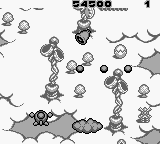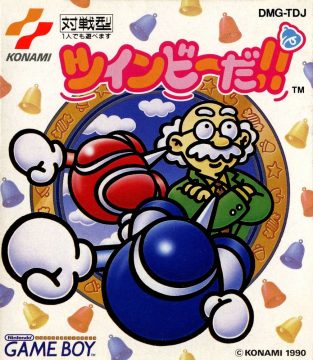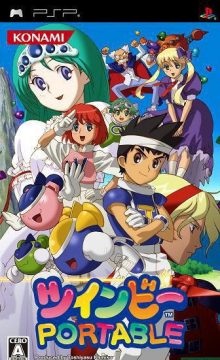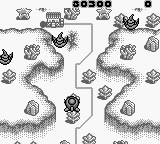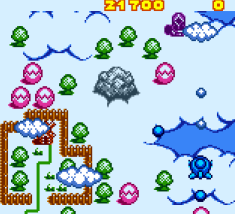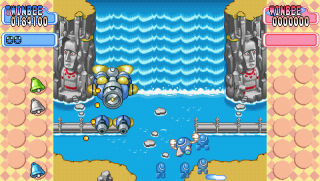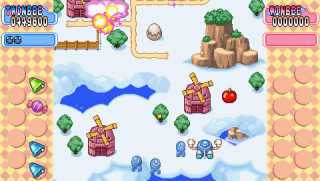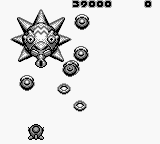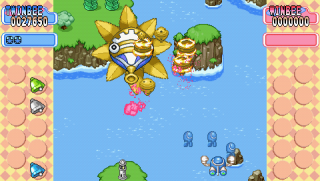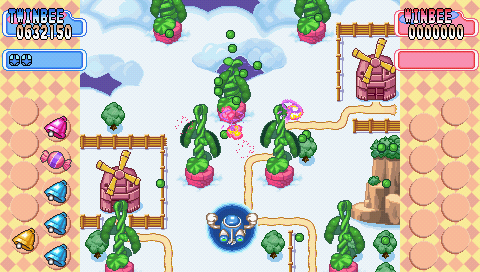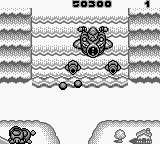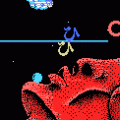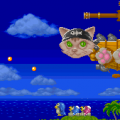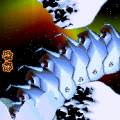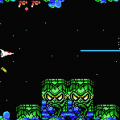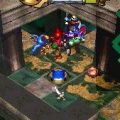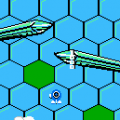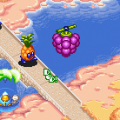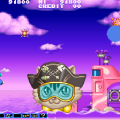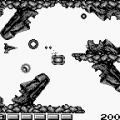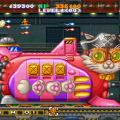TwinBee Da!! lies in the same space as many portable renditions, It’s not really a port, but it’s not original enough to be considered a sequel, either. The mechanics are the same as the arcade game, but the level design is more elaborate, and it has several unique bosses. The graphic style, despite being black and white, is much more detailed than the original game. There are six levels in total, and there are references to some of Konami’s other shooters, like the frazzled looking octopus boss, who seems to have stepped out of Parodius, as well as the laser ring-firing Moai heads from Gradius. Each stage has its own unique power-up theme, like TwinBee 3, and one of the songs is based on the last level track from Stinger / Moero Twinbee.
As with many Game Boy ports, the stages are adjusted to fit the small screen, so it feels pretty cramped. The scrolling is also fairly slow. The larger problem, though, is that TwinBee is really defined by its colorful graphics, so it’s the last game you’d want to play in shades of grey. Plus, distinguishing the bells in this game is a pain. The details look nice in stills, but it’s a little too busy for the small Game Boy screen.
The enemy this time is the evil Dr. Nikki. From a storyline standpoint, it was originally meant to be a sequel to TwinBee 3, but was later retconned in the Detana Twinbee Yahho! Deluxe Pack manual to take place in the same timeline as the first game. You never see him, but the final level features a message from Dr. Nikki: “Welcome to my island but…you shall not return alive. I dare you to fell Cyber Poppo”, after which you face the final boss, a gigantic peacock robot.
Five versions of this game exist: the original Japanese release (1990); the European version, renamed Pop’n Twinbee (1994); the Super Game Boy enhanced version, included in the Japanese Konami GB Collection Vol. 2 (1997); the Game Boy Color version, included in the European Konami GB Collection Vol. 3 (2000); and a remake for the PSP, released as part of the TwinBee Portable compilation (2007). The standalone Game Boy releases included a two-player mode to use with the Game Boy link cable, but both GB Collections removed this. The European version was renamed to capitalize on the popularity of the SNES Pop’n TwinBee, even though the two games are almost nothing alike. The coloring in the Game Boy Color version makes the game a little less drab, but like many games on the platform, the palette choices are garish and ugly.
The PSP version was developed by M2, who ported all of the Konami shooters to portable platforms. The visuals have been totally redrawn in full color. It’s a gorgeous looking game, even though it doesn’t have quite the amount of detail as Yahho!, nor are the designs as inspired. The field is also pillarboxed to maintain a 4:3 aspect ratio. The music is slightly arranged, with instruments that replicate the chiptune sound of the original Game Boy, but much cleaner.
Some things have been cut, however. The two-player mode is gone, and there are only five levels altogether. The original fourth stage boss is absent, and most of the fifth stage is gone completely, with parts of it (and the bosses) moved to stage four. The level select is also missing. This would’ve been disappointing as a standalone title, but as a bonus on the Portable package, it’s a pleasant enough diversion.
